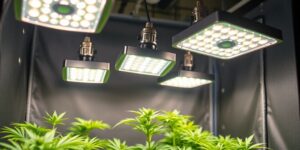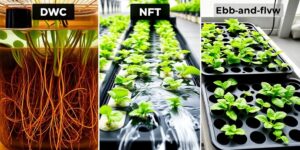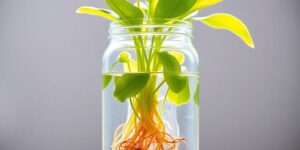Figuring out why your plants aren’t doing so hot can be a real puzzle. Often, the culprit is something you can’t see: the pH and EC levels of your water or soil. These two things are super important for how well your plants can actually use the nutrients you give them. If they’re off, your plants might not grow right, no matter how much you feed them. This guide is all about helping you sort out those pH and EC issues.
Key Takeaways
- Understanding pH (acidity/alkalinity) and EC (nutrient concentration) is vital for plant health and growth.
- Accurate measurements depend on using the right meter, calibrating it properly, and keeping the probes in good shape.
- Knowing the ideal pH and EC ranges for your specific plants helps you spot and fix imbalances.
- Troubleshooting involves adjusting nutrient solutions or water to correct high or low pH and EC levels.
- Regularly cleaning, calibrating, storing meters correctly, and keeping good records are key to consistent pH and EC troubleshooting.
Understanding pH and EC Fundamentals
Alright, let’s get down to the nitty-gritty of what pH and EC actually mean for your plants. It might sound a bit science-y, but honestly, it’s pretty straightforward once you break it down. Think of these two measurements as the vital signs for your plants’ environment, telling you if they’re comfortable and getting what they need.
Defining pH: Acidity and Alkalinity
So, what’s pH? Basically, it’s a scale that tells you how acidic or alkaline your water or growing medium is. The scale runs from 0 to 14. If it’s 7, it’s neutral – like pure water. Anything below 7 is acidic, and anything above 7 is alkaline or basic. For most plants, you’re aiming for a slightly acidic range, usually between 5.5 and 6.5, but this can change depending on what you’re growing. Getting this wrong can really mess with how your plants absorb nutrients. For instance, if your solution gets too alkaline, certain nutrients might just lock up and become unavailable, no matter how much you add. It’s like having food in the fridge but not being able to open it.
Defining EC: Nutrient Concentration
Now, EC stands for Electrical Conductivity. What it’s measuring is how well your water or nutrient solution conducts electricity. Why does that matter? Because the more dissolved salts and minerals (which are basically your plant’s food) are in the water, the better it conducts electricity. So, a higher EC reading means more nutrients are present, and a lower reading means fewer nutrients. You need to find that sweet spot – enough nutrients to feed your plants, but not so much that it burns them. It’s a balancing act, really. Different plants have different appetites, so what works for a tomato plant might not be ideal for lettuce. You can check out general guidelines for nutrient levels to get a better idea.
Why pH and EC Matter for Plant Health
Putting it all together, pH and EC are super important because they directly affect your plants’ ability to thrive. If your pH is off, your plants can’t properly take up the nutrients, even if they’re there. This can lead to deficiencies, where the plant shows signs of lacking certain elements, or toxicities if certain elements become too available. Similarly, if your EC is too low, your plants are essentially starving. Too high, and you risk nutrient burn, which can damage roots and leaves. Keeping both in check is key to healthy growth, bigger yields, and fewer problems down the line. It’s all about creating the best possible environment for your plants to do their thing.
Accurate Measurement Techniques
Getting accurate measurements from your pH and EC meters is super important if you want your plants to do well. It’s not just about having the right tools, but also knowing how to use them correctly. Think of it like this: if you’re trying to bake a cake, using a broken measuring cup will just lead to a mess, right? Same idea here.
Selecting the Right pH and EC Meter
First off, you need to pick a meter that fits what you’re doing. There are tons of options out there, from simple handheld ones to more complex systems. For most home growers, a good quality handheld meter is usually enough. Look for one that feels sturdy and has clear readings. Some meters measure both pH and EC, which can be handy. When you’re looking, check out what other growers say about different brands. Sometimes, spending a little more upfront means you get something that lasts longer and is more reliable. For example, some meters are built for continuous monitoring, which might be overkill if you’re just checking your reservoir now and then. It’s worth looking into AlpHa Measurement Solutions if you need something precise.
Proper Meter Calibration Procedures
Calibration is probably the most critical step. Without it, your readings are basically guesses. You’ll need calibration solutions for both pH and EC. For pH, you typically use buffer solutions, usually pH 4.0, 7.0, and sometimes 10.0. You dip the probe into each solution, let it stabilize, and tell the meter what the reading should be. It’s like teaching the meter its ABCs.
Here’s a basic rundown for pH calibration:
- Rinse the probe: Always rinse with distilled or deionized water before and after each calibration step.
- Calibrate to pH 7.0: Immerse the probe in the pH 7.0 buffer solution. Wait for the reading to stabilize, then confirm the calibration.
- Calibrate to pH 4.0 (or 10.0): Rinse the probe, then immerse it in the pH 4.0 buffer solution (or pH 10.0 if your plants prefer a more alkaline environment). Wait for stabilization and confirm.
EC meters also need calibration, usually with a standard EC solution of a known value, like 2.77 mS/cm. The process is similar: rinse, immerse, wait for stabilization, and confirm.
Don’t skip calibration, even if your meter seems to be working fine. Things change, and recalibrating regularly keeps your measurements honest.
Ensuring Probe Integrity for Accurate Readings
Your meter’s probe is the part that actually touches the solution, so it’s pretty important. Probes can get dirty, clogged, or even damaged, which messes up your readings. After every use, you should rinse the probe with distilled water. If you see any gunk building up, gently clean it with a soft cloth or a specialized probe cleaner. Never use anything abrasive. Also, make sure the probe isn’t dry when you store it. Most come with a storage solution or a cap that holds a bit of it. Keeping the probe wet prevents it from drying out and becoming less sensitive. If you notice your readings are all over the place or the probe looks cloudy or cracked, it might be time to replace it. A damaged probe can’t give you good data, no matter how well you calibrate.
Interpreting Your Readings
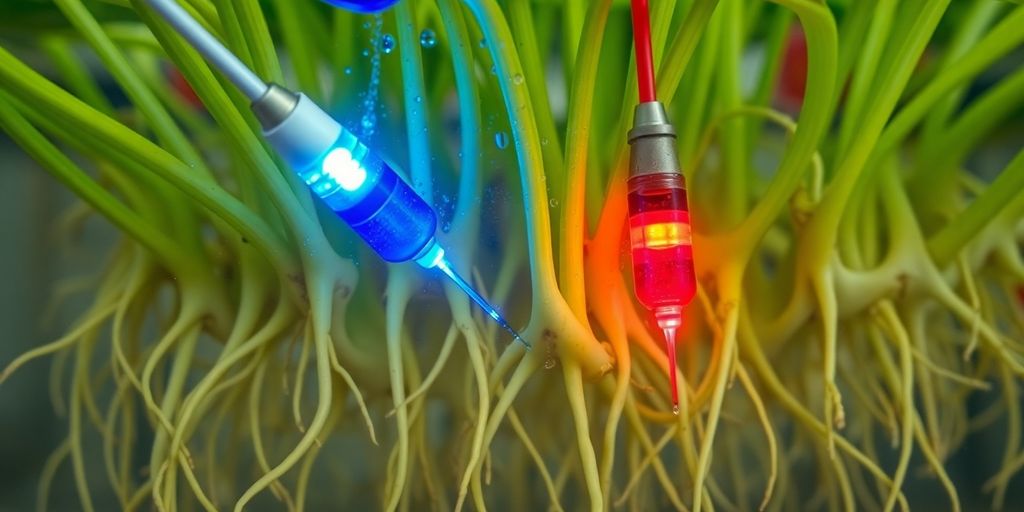
Ideal pH Ranges for Various Plants
Different plants have different needs when it comes to pH. Getting this right means your plants can actually absorb the nutrients you’re giving them. Too high or too low, and those nutrients just sit there, useless. Most common vegetables and flowers do well in a slightly acidic range, usually between 6.0 and 6.5. But, some plants, like blueberries or azaleas, prefer it even more acidic, while others, like some leafy greens, can tolerate a slightly higher pH. It’s always a good idea to check the specific needs of what you’re growing.
- Leafy Greens: Often prefer pH 6.0 – 7.0
- Fruiting Plants (Tomatoes, Peppers): Typically thrive between pH 6.0 – 6.8
- Root Vegetables: Can tolerate a slightly wider range, often 6.0 – 7.0
Understanding Optimal EC Levels
EC, or electrical conductivity, tells you how many dissolved salts, which are basically your plant’s food, are in your water or nutrient solution. Think of it as the strength of the feed. Too weak, and your plants won’t get enough food. Too strong, and you risk burning their roots. The sweet spot varies a lot by plant type and growth stage. Young seedlings need a much lower EC than mature, fruiting plants. For example, a general range for many common plants might be between 1.2 and 2.0 mS/cm, but you’ll want to fine-tune this. If you’re using hard water, you might need to adjust your nutrient mix, as mentioned in guides on hydroponic nutrient strength.
Here’s a general idea:
- Seedlings/Clones: EC 0.4 – 0.8 mS/cm
- Vegetative Growth: EC 1.0 – 1.6 mS/cm
- Flowering/Fruiting: EC 1.4 – 2.2 mS/cm
Recognizing Signs of Imbalance
Spotting problems early is key. If your pH is too high, you might see yellowing leaves, especially on the newer growth, because iron and other micronutrients aren’t being absorbed. This is often called chlorosis. On the flip side, if the pH is too low, you might see signs of nutrient burn or toxicity, even if you haven’t overfed, because essential nutrients can become overly available and damage the plant. For EC, if it’s too low, plants will look generally weak, with slow growth and pale leaves. If the EC is too high, you’ll see leaf tips and edges turning brown and crispy – that’s nutrient burn. It’s a clear sign the solution is too concentrated for the plant to handle.
Paying attention to how your plants look is just as important as looking at your meter. Your plants will often tell you if something is wrong before the numbers get too far out of whack. It’s a constant conversation between you, your meter, and your plants.
Troubleshooting Common pH Issues
Addressing High pH Levels
So, your pH is creeping up, huh? This usually means your nutrient solution is becoming too alkaline. Plants can’t grab onto nutrients when the pH is too high, which is a big problem. Think of it like trying to unlock a door with the wrong key – the nutrients are there, but the plant just can’t use them. This can lead to deficiencies even if you’re feeding them perfectly. The most common culprit for high pH is often the water you’re using, especially if it’s tap water.
Here’s what you can do:
- Use pH Down: This is usually a phosphoric or nitric acid solution. Add it very slowly, a little at a time, and stir well. Wait a bit, then re-test. You don’t want to shock your plants by dropping the pH too fast.
- Check Your Water Source: If your tap water consistently has a high pH, you might need to let it sit out for 24 hours to allow dissolved gases to escape, which can sometimes lower the pH. Or, consider using filtered or reverse osmosis (RO) water, which gives you a cleaner slate.
- Buffering Capacity: Some growing media and nutrient solutions have a buffering capacity, meaning they resist changes in pH. If your pH is constantly rising, your buffer might be depleted, or you might need to adjust your base nutrient solution.
Correcting Low pH Readings
On the flip side, if your pH is too low, your plants are in an acidic environment. This can make certain nutrients too available, leading to toxicities or nutrient lockout. For example, if cannabis soil pH drops below 6.0, essential nutrients become overly available, potentially causing toxicities. This indicates an acidic environment that requires correction to ensure optimal plant health and nutrient absorption. You might see symptoms like burnt leaf tips or stunted growth.
Here’s how to fix it:
- Use pH Up: Similar to pH Down, this is typically a potassium hydroxide solution. Add it gradually, stir, and re-test. Go slow to avoid overcorrection.
- Consider Your Nutrients: Some nutrient lines can naturally lower pH over time. If you’re using a lot of certain types of nutrients, this might be the cause.
- Growing Medium: The type of soil or soilless mix you’re using can also influence pH. Some media are naturally more acidic.
Impact of pH on Nutrient Uptake
This is where pH really shines, or rather, where it can cause major problems if it’s off. Think of the pH scale as a series of gates for different nutrients. Each nutrient has an ideal pH range where it’s most available for the plant to absorb through its roots. If the pH is too high or too low, those gates slam shut for certain nutrients.
Here’s a simplified look at how pH affects key nutrients:
| Nutrient | Ideal pH Range for Uptake | Too High pH (Less Available) | Too Low pH (Less Available) | Potential Toxicity at Low pH |
|---|---|---|---|---|
| Nitrogen (N) | 5.5 – 7.0 | Moderate | Moderate | Yes |
| Phosphorus (P) | 6.0 – 7.0 | High | Moderate | Yes |
| Potassium (K) | 5.5 – 7.0 | Moderate | Moderate | Yes |
| Calcium (Ca) | 6.0 – 7.0 | High | Moderate | No |
| Magnesium (Mg) | 6.0 – 7.0 | High | Moderate | No |
| Iron (Fe) | 5.5 – 6.5 | Very High | Moderate | Yes |
| Manganese (Mn) | 5.5 – 6.5 | Very High | Moderate | Yes |
Remember, these are general ranges. Different plants have slightly different preferences, and the specific type of growing medium can also play a role. Always aim for the sweet spot for your particular crop to avoid nutrient issues. Keeping your pH in check is a big part of making sure your plants can actually use the food you’re giving them. It’s all about making those nutrients accessible, and for that, you need the right pH. You can find more information on nutrient availability at e1cc.
Troubleshooting Common EC Issues
Managing Excessively High EC Levels
So, your EC meter is showing a reading that’s a bit too high? Don’t panic. This usually means there are too many nutrients dissolved in your water or nutrient solution. The most common reason for this is simply adding too much fertilizer. It’s easy to get a little overzealous when you want your plants to grow big and strong, but too much can actually be harmful. Think of it like feeding a person too much; they won’t feel good.
When EC levels get too high, plants can experience what’s called nutrient burn. You might see the tips of the leaves turning brown or looking crispy. This happens because the plant is taking in so many nutrients that it can’t process them all, and the excess salts build up. Another issue is nutrient lockout, where the high concentration of salts can actually prevent the plant from absorbing other necessary nutrients, even if they’re present.
So, what do you do? The simplest fix is to add more clean water to your solution. This dilutes the concentration of nutrients, bringing the EC down. You might need to do this a few times, checking the EC after each addition, until you reach the desired level. If you’re using a soil-based system, you might need to flush the medium with plain water to wash away the excess salts. This is a bit like giving the roots a fresh start. For hydroponic growers, this means replacing some of the existing nutrient solution with fresh water.
Boosting Insufficient EC Levels
On the flip side, what if your EC reading is too low? This means your plants aren’t getting enough food. It’s like trying to run a marathon on an empty stomach – they just won’t have the energy to grow properly. Low EC levels can lead to deficiencies, where plants lack specific nutrients they need. You might notice stunted growth, pale leaves, or yellowing between the veins of the leaves.
To fix this, you’ll need to increase the nutrient concentration. The most straightforward way is to add more of your nutrient solution. Start by adding a small amount, mix it well, and then re-test your EC. You want to gradually increase it until you hit the sweet spot for your particular plants. It’s always better to add a little at a time and check, rather than dumping in a lot and overshooting the mark. Remember, different plants have different needs, so knowing the ideal range for your crop is key. You can find good charts online that help you match EC levels to plant growth stages.
Nutrient Burn vs. Nutrient Deficiency
It’s pretty important to be able to tell the difference between too much and too little food for your plants. They can sometimes look a bit similar, but the causes and solutions are totally different.
- Nutrient Burn: This is what happens when EC levels are too high. The edges and tips of the leaves often turn brown and crispy. It’s like a plant getting a sunburn, but from too many nutrients.
- Nutrient Deficiency: This occurs when EC levels are too low, or when nutrient lockout is happening due to other issues. Leaves might turn pale yellow, or you might see yellowing between the leaf veins, especially on older leaves first. Growth will likely be slow and weak.
Getting these readings right and knowing how to adjust them is a big part of keeping your plants happy and healthy. It’s all about finding that balance where they get just the right amount of food to thrive, without getting too much or too little. Regularly checking your EC and making small, informed adjustments is the way to go.
If you’re dealing with a buildup of salts from over-fertilizing, flushing your system with plain water is a good way to reset things. You can learn more about how flushing helps clear out excess salts here.
Maintaining Meter Accuracy Over Time
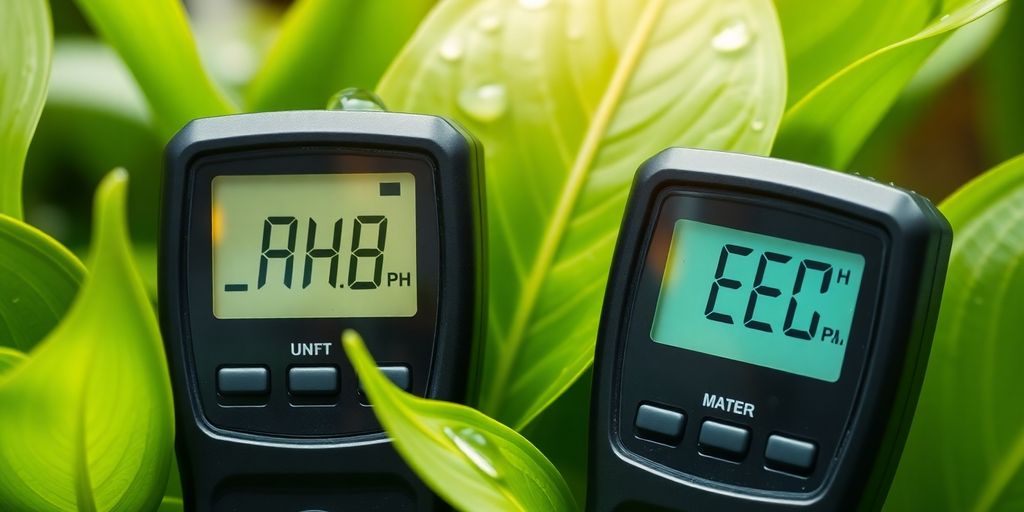
Keeping your pH and EC meters in good shape is super important if you want reliable readings. It’s not just about buying a good meter; you’ve got to look after it. Think of it like taking care of any tool – a little effort goes a long way in making sure it works right.
Regular Cleaning and Maintenance
After you use your meter, the first thing you should do is rinse the probe. Use distilled or deionized water for this. This gets rid of any leftover nutrient solution or whatever you were measuring, stopping gunk from building up and messing with future readings. Don’t just leave it to dry out with stuff on it. Also, give the probe a gentle wipe with a soft cloth if you see any residue. Never use abrasive materials or harsh chemicals on the probe, as this can damage it.
Proper Storage Solutions
How you store your meter when you’re not using it really matters. Most pH probes need to be kept moist. They usually come with a special storage solution. If you lose that, you can often use a pH 4 buffer solution or a specific electrode storage solution. Just make sure the probe is fully submerged. Storing it dry can damage the sensitive membrane and make it less accurate, or even stop it from working altogether. For EC probes, keeping them clean and dry is usually best, but always check the manufacturer’s instructions. Storing your meter in its protective case is also a good idea to prevent accidental bumps or drops.
When to Replace Meter Probes
Even with the best care, probes don’t last forever. They’re the part that actually does the sensing, and they can wear out or get damaged. You might notice your meter is taking longer to give a stable reading, or the readings seem all over the place even after calibration. Sometimes, you might see visible damage like cracks or a cloudy appearance on the probe. If you’re having trouble calibrating or the readings just don’t seem right anymore, it’s probably time to think about getting a new probe. Replacing the probe is often much cheaper than buying a whole new meter, and it can bring your old meter back to life. You can find replacement probes for most popular meters online, like those for measuring EC levels.
Record Keeping for Effective Management
Keeping good records of your pH and EC readings is super important if you want your plants to do their best. It’s not just about checking the numbers once in a while; it’s about seeing what’s happening over time and figuring out why things might be going wrong, or even better, why they’re going right.
The Importance of Detailed Logs
Think of your logbook as a plant diary. Every time you test your nutrient solution or runoff, you write it down. What did you measure? What was the temperature? What did you feed the plants? This detailed history is your best tool for spotting problems before they get serious. It helps you understand how your actions affect your plants. For example, you might notice that after adding a certain amount of a specific nutrient, your EC spikes, and then your plants show signs of stress. Without a record, you might never connect those two events. Keeping these logs is also really helpful if you ever need to explain your growing methods to someone else, like a mentor or even just for your own reference next season. It’s a good idea to jot down observations about the plants themselves too – like leaf color, growth rate, or any weird spots. This gives you a fuller picture. You can find more info on managing nutrients in our guide to adding nutrients.
Identifying Trends in Your Data
Once you start logging, you’ll begin to see patterns. Maybe your pH always creeps up after a few days, or your EC drops faster than you expect. These trends tell you what your system is doing naturally. For instance, if your EC consistently drops, it means your plants are drinking more than they are eating, which is usually a good sign. But if it drops too quickly, they might be getting too much of something. Conversely, if your EC keeps climbing, it might mean your plants aren’t taking up nutrients as they should, or you’re adding too much. Spotting these trends lets you make small adjustments proactively, rather than waiting for a big problem to show up. It’s like knowing when to top up your car’s oil before the warning light comes on.
Making Informed Adjustments Based on Records
Your records aren’t just for looking at; they’re for doing things. If your logs show a consistent pH drift, you can adjust your feeding schedule or the buffering capacity of your water. If you see EC levels that are consistently too high, you might need to dilute your nutrient solution more often or use less concentrated feed.
Here’s a simple way to think about it:
- Problem: EC is consistently too high.
- Record Analysis: Logs show you’ve been adding the same amount of nutrients, but plant uptake has slowed.
- Informed Adjustment: Reduce the concentration of your nutrient mix by 10% for the next feeding, and monitor the EC closely.
Making data-driven decisions takes the guesswork out of plant care. Instead of just guessing what might work, you’re using actual measurements and observations to guide your actions. This approach saves time, resources, and ultimately leads to healthier, happier plants.
Remember to date every entry and be as specific as possible. This diligence will pay off big time in the long run.
Wrapping It Up
So, we’ve gone over how pH and EC meters work and why they’re pretty important for getting your plants to grow well. It might seem like a lot at first, but really, it just takes a little practice. Keep an eye on those readings, clean your gear, and don’t forget to calibrate it now and then. You’ll get the hang of it, and your plants will thank you for it. Happy growing!
Frequently Asked Questions
What exactly is pH, and why should I care about it for my plants?
Think of pH like a scale from 0 to 14. Numbers below 7 mean it’s acidic, like lemon juice. Numbers above 7 mean it’s alkaline, like baking soda. Most plants like it a little bit acidic, usually between 6.0 and 6.5, but this can change depending on the plant. If the pH is too high or too low, plants can’t get the food they need, which can cause problems.
What does EC mean, and how does it relate to plant food?
EC, or electrical conductivity, tells you how many nutrients are in your plant’s food or water. A higher number means more nutrients, and a lower number means fewer. You want to find the sweet spot that gives your plants the right amount of food. Too much can burn them, and too little means they won’t grow well.
How do I make sure my pH and EC meters are giving me the right numbers?
To get accurate readings, you need to make sure your pH and EC meters are clean and working correctly. This means cleaning the probes often and using special solutions to check and adjust the meter’s settings, which is called calibrating. It’s like making sure your tools are sharp and ready before you start a project.
Why is it important to write down my pH and EC readings?
Keeping track of your pH and EC readings is super important! Write down the numbers you get each time you measure. This helps you see if things are changing over time. You might notice a pattern, like the pH always going up after you add nutrients. This information helps you make smart choices about how to feed your plants.
What do I do if my pH or EC numbers are not right?
If your pH is too high, you can use a product called ‘pH down’ to lower it. If it’s too low, you’ll use ‘pH up’. For EC, if it’s too high, you might need to add more plain water to your nutrient mix. If it’s too low, you’ll add more nutrient solution.
Do I really need to clean and take care of my meter’s probes?
Yes, you do! Probes can get dirty or worn out over time, which makes them give wrong readings. It’s a good idea to clean them after every use and store them properly in a special liquid. You might also need to replace the probe every year or two, depending on how much you use it, to keep your measurements accurate.


